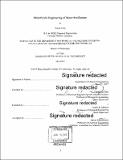Microfluidic engineering of water purification
Author(s)
Choi, Siwon (Siwon Chloe)
DownloadFull printable version (13.38Mb)
Other Contributors
Massachusetts Institute of Technology. Department of Chemical Engineering.
Advisor
Jongyoon Han and Karen K. Gleason.
Terms of use
Metadata
Show full item recordAbstract
The demand for clean water has been increasing for several reasons, such as rapid industrialization of developing countries, environmental pollution and climate change, and development of biofuels and the resulting irrigation growth. To meet the needs for this growing demand for clean water, desalination has become an appealing solution as saline water (brackish water, seawater and brine) are the most abundant water source for most of the world. However, desalination is energy and capital intensive compared to other water treatment processes, and oftentimes it is not economically feasible. Current desalination technologies require further engineering and development to become more sustainable in the long term. My Ph.D thesis is focused on engineering of electromembrane desalination, which is a set of electrically driven desalination technologies that utilize ion transport through ion exchange membranes. We employed microfluidic platforms and numerical modeling tools for the study, for they help reveal novel insights regarding the micro-scale details that are difficult to be discovered from the conventional large-scale systems. In this thesis, we consider three topics: i) engineering of structures that enhance mass transport in electrodialyis (ED), ii) techno-economic analysis of ion concentration polarization (ICP) desalination for high salinity brine treatment, and iii) development of electrocoagulation (EC) - ion concentration polarization (ICP) desalination hybrid that removes dissolved ions and non-ionic contaminants from water in a single device. First, we employed an electrodialysis (ED) system as a model to investigate the mass transport effects of embedded microstructures, also known as spacers, in electromembrane desalination systems. The spacer engineering is especially critical for low salinity (i.e., brackish water) desalination, where the mass transport in the solution is a dominant contributor to the electrical energy consumption in the system. Parametric studies of the spacer design revealed that small cylindrical structures effectively re-distribute the local flow velocity and enhance mass transport in the system. Furthermore, we found that relative diffusivities of cation and anion in the solution should be considered in designing the spacer and that the optimal design should maximize the mass transport while keeping the effect on the hydrodynamic resistance small. Next, we built an empirical model to estimate an electrical energy consumption of ICP desalination and utilized it to obtain the water cost and optimal operating parameters for high salinity applications. We performed cost analyses on two specific cases (i.e., partial desalination of high salinity brine to the seawater level, and brine concentration for salt production) and compared the performance with mainstream desalination technologies for each application. Lastly, we combined two electrical water treatment technologies and created an EC-ICP hybrid for total water treatment, which removes dissolved ions and non-ionic contaminants from the feed solution. We demonstrated a continuous EC-ICP operation that successfully removed salt and suspended solids. Our system is flexible in terms of the system size, and the type and concentration of contaminants it can handle, and thus it can find applications as a portable water treatment system.
Description
Thesis: Ph. D., Massachusetts Institute of Technology, Department of Chemical Engineering, 2017. Cataloged from PDF version of thesis. Includes bibliographical references.
Date issued
2017Department
Massachusetts Institute of Technology. Department of Chemical EngineeringPublisher
Massachusetts Institute of Technology
Keywords
Chemical Engineering.